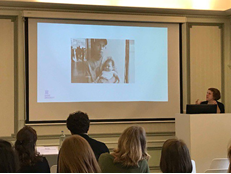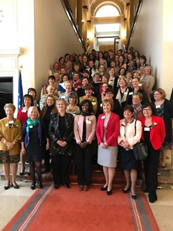Newsletter April 2018
 ICRH Global Newsletter ICRH Global Newsletter 5th of April, 2018
|
Message from the Chair |
| PROJECTS |
| Prevalence of violence against women in Brussels Recently, ICRH finished a prevalence study on violence against women in Brussels Capital Region. The study was commissioned by the Regional Government of Brussels (Department of Equal Opportunities, Brussels Capital Region) and was a randomised population-based study (‘household survey’). The objectives were to conduct a policy-oriented study on prevalence, characteristics and consequences of violence against women living in the Brussels Capital Region. The study showed that 86% of the participants experienced some form of sexual harassment, 54.7% reported physical and/or sexual violence by a non-partner, a similar percentage (54.9%) reported partner violence, 17.3% experienced stalking and 42.3% experienced child abuse. The study results were presented to the press on 7 March 2018, and will be disseminated at a conference in June 2018. More information: An-Sofie Van Parys, An-Sofie.VanParys@uzgent.be or Els Leye, Els.Leye@ugent.be. |
Gender based violence on campuses in Uganda |
| EVENTS |
Webinar on refugee and migrant health |
| Gender norms and adolescence On 30 March 2018, ICRH organized a conference on social (gender) norms and adolescent (sexual) health.  This event fits within the framework of the Global Minds Sensitizing Events of Ghent University and Belmundo, the international solidarity festival of the City of Ghent. During the morning session various (research) experiences on the influence of social norms on adolescent health were shared by Peter Decat (Department of Family Medicine and Primary Health Care, Ghent University), Sara De Meyer (ICRH Belgium) and Rebecka Lundgren (Institute for Reproductive Health, Georgetown University). Christophe Ramont (Department of International Relations and Networks of the City of Ghent) closed the morning session by pointing out how local authorities can take into account social norms when providing health services and solving major health issues. Sarah Van de Velde (Centre for Longitudinal and Life Course Studies, University of Antwerp) started the afternoon session explaining (the measurement of) gender norms and their impact on health. Subsequently Joz Motmans (Gender Studies, Ghent University - Coordinator Transgender Infopunt, University Hospital Ghent) and Nina Van Eekert (Phd student, University of Antwerp) illustrated from their expertise on transsexuality and Female Genital Cutting how gender norms and adolescent health are interconnected. Rebecka Lundgren explained how interventions on gender norms with local communities can contribute to an improvement of adolescent sexual health. Els Elaut (Centre for Sexology and Gender, University Hospital Ghent) and Emilie Peeters (Reproductive Health Supplies Coalition) started the final debate on how we can contribute to the sexual health of adolescents by focusing on social (gender) norms. This event fits within the framework of the Global Minds Sensitizing Events of Ghent University and Belmundo, the international solidarity festival of the City of Ghent. During the morning session various (research) experiences on the influence of social norms on adolescent health were shared by Peter Decat (Department of Family Medicine and Primary Health Care, Ghent University), Sara De Meyer (ICRH Belgium) and Rebecka Lundgren (Institute for Reproductive Health, Georgetown University). Christophe Ramont (Department of International Relations and Networks of the City of Ghent) closed the morning session by pointing out how local authorities can take into account social norms when providing health services and solving major health issues. Sarah Van de Velde (Centre for Longitudinal and Life Course Studies, University of Antwerp) started the afternoon session explaining (the measurement of) gender norms and their impact on health. Subsequently Joz Motmans (Gender Studies, Ghent University - Coordinator Transgender Infopunt, University Hospital Ghent) and Nina Van Eekert (Phd student, University of Antwerp) illustrated from their expertise on transsexuality and Female Genital Cutting how gender norms and adolescent health are interconnected. Rebecka Lundgren explained how interventions on gender norms with local communities can contribute to an improvement of adolescent sexual health. Els Elaut (Centre for Sexology and Gender, University Hospital Ghent) and Emilie Peeters (Reproductive Health Supplies Coalition) started the final debate on how we can contribute to the sexual health of adolescents by focusing on social (gender) norms.For more information: SaraA.DeMeyer@ugent.be, Twitter: @ICRHugent. |
PUBLICATIONS |
| Are older women forgotten in the fight against sexual violence? In light of the Women's Day on March 8, a Lancet comment of among others ICRH researchers drew attention to the risk of neglecting older women in the discourse on women's rights and in the recent campaigns around sexual victimisation. The full text is available at https://www.sciencedirect.com/science/article/pii/S2214109X18300743 Nobels A, Vandeviver C, Beaulieu M, Lemmens GM, Keygnaert I. Are older women forgotten in the fight against sexual violence? Lancet Glob Health. 2018 Apr;6(4):e370. doi: 10.1016/S2214-109X(18)30074-3. Epub 2018 Mar 7. |
| Age disparities and HIV transmission Partner age differences and associated sexual risk behaviours among adolescent girls and young women in a cash transfer programme for schooling in Malawi Age disparities in sexual relationships have been proposed as a key risk factor for HIV transmission in Sub-Saharan Africa, but evidence remains inconclusive. The SIHR study, a cluster randomised trial of a cash transfer programme in Malawi, found that young women in the intervention groups were less likely to have had a sexual partner aged 25 or older, and less likely to test positive for HIV and HSV-2 at follow-up compared to control groups. The authors examined the hypotheses that girls in the intervention groups had smaller age differences than control groups and that large age differences were associated with relationship-level HIV transmission risk factors: inconsistent condom use, sex frequency, and relationship duration. An analysis was conducted of schoolgirls in the Schooling, Income, and Health Risk (SIHR) study aged 13-22 at baseline (n = 2907). The researchers investigated the effects of study arm, trial stage and participant age on age differences in sexual relationships using a linear mixed-effects model. Cumulative-link mixed-effects models were used to estimate the effect of relationship age difference on condom use and sex frequency, and a Cox proportional hazard model was used to estimate the effect of relationship age difference on relationship duration. They controlled for the girl’s age, number of partners, study group and study round. Girls receiving cash transfers, on average, had smaller age differences in relationships compared to controls, though the estimated difference was not statistically significant (− 0.43 years; 95% CI: -1.03, 0.17). The older the participant was, the smaller her age differences (− 0.67 per 4-year increase in age; 95% CI: -0.99, − 0.35). Among controls, after the cash transfers had ended the average age difference was 0.82 years larger than during the intervention (95% CI: 0.43, 1.21), suggesting a possible indirect effect of the study on behaviour in the community as a whole. Across treatment groups, larger age differences in relationships were associated with lower levels of condom use, more frequent sex, and longer relationship durations. The authors conclude that cash-transfer programmes may prevent HIV transmission in part by encouraging young women to form age-similar relationships, which are characterised by increased condom use and reduced sex frequency. The benefits of these programmes may extend to those who are not directly receiving the cash. Roxanne Beauclair, Jonathan Dushoff and Wim Delva. Partner age differences and associated sexual risk behaviours among adolescent girls and young women in a cash transfer programme for schooling in Malawi. BMC Public Health (2018) 18:403 https://doi.org/10.1186/s12889-018-5327-7. |
| Maternal death in Mozambique An analysis of mortality data to examine the contribution of delays in accessing emergency obstetric care in relation to the causes of death. Despite declining trends maternal mortality remains an important public health issue in Mozambique. The delays to reach an appropriate health facility and receive care faced by woman with pregnancy related complications play an important role in the occurrence of these deaths. This study aims to examine the contribution of the delays in relation to the causes of maternal death in facilities in Mozambique. Secondary analysis was performed on data from a national assessment on maternal and neonatal health that included in-depth maternal death reviews, using patient files and facility records with the most comprehensive information available. Statistical models were used to assess the association between delay to reach the health facility that provides emergency obstetric care (delay type II) and delay in receiving appropriate care once reaching the health facility providing emergency obstetric care (delay type III) and the cause of maternal death within the health facility. Data were available for 712 of 2,198 maternal deaths. Delay type II was observed in 40.4% of maternal deaths and delay type III in 14.2%.and 13.9% had both delays. Women who died of a direct obstetric complication were more likely to have experienced a delay type III than women who died due to indirect causes. Women who experienced delay type II were less likely to have also delay type III and vice versa. The authors conclude that the delays in reaching and receiving appropriate facility-based care for women facing pregnancy related complications in Mozambique contribute significantly to maternal mortality. Securing referral linkages and health facility readiness for rapid and correct patient management are needed to reduce the impact of these delays within the health system. Chavane LA, Bailey P, Loquiha O, Dgedge M, Aerts M, Temmerman M. Maternal death and delays in accessing emergency obstetric care in Mozambique. BMC Pregnancy Childbirth. 2018 Mar 22;18(1):71. doi: 10.1186/s12884-018-1699-z. |
| Underreporting of deaths in the maternal deaths surveillance system. An assessment of the reliability of maternal deaths surveillance system (MDSS) with the aim to determine the factors that influence its completeness in one region of Morocco. A retrospective survey in "Gharb Chrarda Bni Hssen" region (GCBH) was conducted between January the 1st, 2013 and September the 30th, 2014 using multiple sources approach. All deaths of women of reproductive age (WRA) were investigated using certificates with medical cause, medical records and interviews with household members and relatives to ascertain a pregnancy-related or maternal death. An External Expert Committee reviewed the information collected to assign a cause for each death. The results were compared to those reported in the same period by the MDSS. The study identified 690 deaths of WRA and 69 maternal deaths of which 34.8% occurred outside health facilities. The MDSS recorded during the study period 538 deaths of WRA and 29 maternal deaths (including only one outside health facility) representing respectively an underreporting of 22.0% and 58.0%. Late maternal deaths represented 11.4% of all deaths of women with a registered pregnancy within 12 months prior to the death, while the MDSS identified none. The maternal mortality ratio (MMR) was estimated at 103, approximately 2.5 times higher than that reported in the MDSS. The study has shown weaknesses in the current notification system for maternal deaths in the region of GCBH. Therefore, more attention must be given to the regional committees in charge of auditing the cases and defining actions to be implemented to prevent further maternal deaths. Abouchadi S, Zhang WH, De Brouwere V.Underreporting of deaths in the maternal deaths surveillance system in one region of Morocco. PLoS One. 2018 Jan 31;13(1):e0188070. doi: 10.1371/journal.pone.0188070. eCollection 2018. |
| Female genital mutilation/cutting in Italy An enhanced estimation for first generation migrant women based on 2016 survey data. Migration flows of women from Female Genital Mutilation/Cutting practicing countries have generated a need for data on women potentially affected by Female Genital Mutilation/Cutting. This paper presents enhanced estimates for foreign-born women and asylum seekers in Italy in 2016, with the aim of supporting resource planning and policy making, and advancing the methodological debate on estimation methods. The estimates build on the most recent methodological development in Female Genital Mutilation/Cutting direct and indirect estimation for Female Genital Mutilation/Cutting non-practicing countries. Direct estimation of prevalence was performed for 9 communities using the results of the survey FGM-Prev, held in Italy in 2016. Prevalence for communities not involved in the FGM-Prev survey was estimated using to the 'extrapolation-of-FGM/C countries prevalence data method' with corrections according to the selection hypothesis. It is estimated that 60 to 80 thousand foreign-born women aged 15 and over with Female Genital Mutilation/Cutting are present in Italy in 2016. The presence among asylum seekers to Italy in 2014-2016 is estimated at around 11 to 13 thousand cut women aged 15 and over. Due to the long established presence of female migrants from some practicing communities Female Genital Mutilation/Cutting is emerging as an issue also among women aged 60 and over from selected communities. Female Genital Mutilation/Cutting is an additional source of concern for slightly more than 60% of women seeking asylum. The authors conclude that reliable estimates on Female Genital Mutilation/Cutting at country level are important for evidence-based policy making and service planning. This study suggests that indirect estimations cannot fully replace direct estimations, even if corrections for migrant socioeconomic selection can be implemented to reduce the bias. Ortensi LE, Farina P, Leye E. Female genital mutilation/cutting in Italy: an enhanced estimation for first generation migrant women based on 2016 survey data. BMC Public Health. 2018 Jan 12;18(1):129. doi: 10.1186/s12889-017-5000-6. |


 March was an exciting month for women, girls and adolescents. International Women’s Day on March 8th, CSW ( Commission on the Status of Women) 62, the launch of the Global Health 50/50 Report, and many other events.
March was an exciting month for women, girls and adolescents. International Women’s Day on March 8th, CSW ( Commission on the Status of Women) 62, the launch of the Global Health 50/50 Report, and many other events. Proud to highlight the work of ICRH Global this month in Belgium, where I had the honour to give a key lecture on empowerment of women for the Lions Club International, in the presence of the newly elected Lions Clubs International First female Vice President Gudrún Björt Yngvadóttir. The event took place in the Belgian Senate, my former place of work. Grateful to the Lions Club Belgium for their kind donation of 2,500 Euro for the ICRH-Kenya led Gender- Based Violence and Recovery Centre in Mombasa, Kenya.
Proud to highlight the work of ICRH Global this month in Belgium, where I had the honour to give a key lecture on empowerment of women for the Lions Club International, in the presence of the newly elected Lions Clubs International First female Vice President Gudrún Björt Yngvadóttir. The event took place in the Belgian Senate, my former place of work. Grateful to the Lions Club Belgium for their kind donation of 2,500 Euro for the ICRH-Kenya led Gender- Based Violence and Recovery Centre in Mombasa, Kenya.